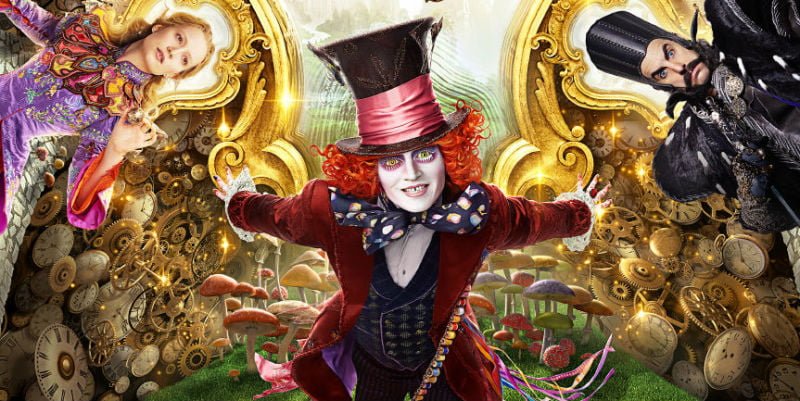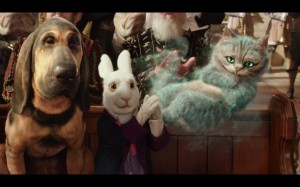
As demonstrated time and time again in the world of cinema, sequels are tricky things. Some are born from a natural extension of a first film – a connection with a film and it’s storied inhabitants that breeds the natural progression of telling more of the tale. Many, however, are born from a studio’s desire to make more money and “cash in” on an existing audience and “property value” in terms of already-established universes, characters, etc. These types of sequels are likely what are referred to in executive board rooms as “safe bets;” projects that will make more money from marketing and ticket sales than the amount of money it costs to make the film, which would make the film a “win” in a businessperson’s eyes, regardless of the critical or emotional response to what the film actually offers.
I’m sad to have to report that ‘Alice Through the Looking Glass’ falls into the latter category of sequels: one that was green-lit and made “because:” because people (especially families and children) know and like the characters. Because Lewis Carroll wrote a “sequel” book that already exists, 1871’s “Through the Looking-Glass, and What Alice Found There,” even though the differences (read: liberties) the film utilizes are quite substantial in nature (more on this below). Because the numbers will almost assuredly add up; the film’s budget is $170 million, right on par with the amount it cost to make the original Tim Burton-helmed ‘Alice in Wonderland,’ and that movie made over $1 billion in global box office sales. So, y’know… “safe bet” and all.
What all these “becauses” don’t add up to is a film that feels particularly inspired or even needed at all. In a sea of movies that has been increasingly populated in the last decade or so with more “fantastical” movies than ever – superhero films everywhere you look, children’s movies that have significantly ratcheted up their production and entertainment values, and sci-fi/fantasy films on a significant upswing in terms of the uniqueness of the stories being told – ‘Alice Through the Looking Glass’ doesn’t do anything to make itself stand out at all; if anything, all it does is recycle often-used ideas from the film categories I just mentioned.
To quickly lay out the plot for you: the film opens with Alice at sea as the Captain of the “Wonder,” her late father’s ship; she’s been away from home and working to establish trade routes with China for over the last three years. As Alice returns to London, she begins to think about what she wants to do with her life, an issue exacerbated when she discovers that she needs to sell her ship to Hamish Ascot, the man from whom she turned down a marriage proposal, in order to get her mother’s house back. At Hamish’s estate, Alice follows a blue butterfly she believes to be Absolem, the caterpillar-turned-butterfly, into a bedroom with a huge mirror (looking-glass), which she promptly walks through in order to re-enter Wonderland. Once there, she discovers that the Mad Hatter has gone even madder, becoming isolated and erratic. In order to save him, Alice takes a trip to visit Time himself, stealing a time-traveling device and visiting the past to discover the source of the issue.
 Admit it – sounds pretty “meh,” right? For me, the biggest knock on the plot is that nothing really happens with any direct purpose. There’s no real reason for Alice to go back to Wonderland (a place so fantastical that it’s apparently readily accessible to most homes), she just sort of… goes. All the characters from the first film gather together, but why? Yes, the issue with the Hatter is the supposed reason, but just because someone is acting a bit moody doesn’t really mean you have to gather the Fellowship of the Ring, you know? Just because the Hatter is being cagey with the reasons he’s down in the dumps doesn’t really necessitate a perilous journey for Alice to put all of time and space at risk by her traversing the timeline, does it?
Admit it – sounds pretty “meh,” right? For me, the biggest knock on the plot is that nothing really happens with any direct purpose. There’s no real reason for Alice to go back to Wonderland (a place so fantastical that it’s apparently readily accessible to most homes), she just sort of… goes. All the characters from the first film gather together, but why? Yes, the issue with the Hatter is the supposed reason, but just because someone is acting a bit moody doesn’t really mean you have to gather the Fellowship of the Ring, you know? Just because the Hatter is being cagey with the reasons he’s down in the dumps doesn’t really necessitate a perilous journey for Alice to put all of time and space at risk by her traversing the timeline, does it?
Listen, I don’t want to sound like too much of a downer on this film, because it’s not bad, per se. The visuals of the film are purely stunning – because almost all of the screen time is spent either in Wonderland or in the “Ocean of Time,” the audience is treated to some truly spectacular effects. Our screening of the film was in 3D, and I highly recommend it as the preferred viewing format of this movie. In addition, the cast has all returned, and they all turn in excellent performances – Johnny Depp and Anne Hathaway continue their quirky work on their respective characters of the Mad Hatter and the White Queen. The voice talent carries on the great work they did with their characters in the first film, particularly Stephen Fry as the (sorely underused) Cheshire Cat and the late, great Alan Rickman in his very last screen work as Absolem. I wasn’t a huge fan of Helena Bonham-Carter’s constantly-screaming Red Queen, and Sasha Baron Cohen appears to be channeling his inner Christoph Waltz a bit too much for the heavily-accented character of Time. It also bears noting that Tim Burton served only as a producer of this film – James Bobin was the director, and as you’ve probably guessed from my comments so far, I think he did a “just okay” job, considering the overall circumstances he was working with.
Much of the characters and plot points of the original tale of Carroll’s “Through the Looking Glass, and What Alice Found There” were heavily cherry-picked for the first ‘Alice in Wonderland’ film, so this movie functions as a big-screen representation of the tale mostly in name only. Perhaps this is part of the issue as to why the film feels so disjointed and plot-deprived. No matter which way you look at it, things really boil down to this: you would likely not hate this film if you saw it, but it would also just as likely be quickly forgotten. Is that really what you want to happen when you go see a movie?
![]()
Tony Schaab created the fan film ‘Star Trek: The Humpbacks Strike Back’ in his head, but probably won’t ever shoot any footage for fear of being sued. Probably. A lover of most things sci-fi and horror, Tony is an author by day and a DJ by night. Come hang out with Tony on Facebook and Twitter to hear him spew semi-funny nonsense and get your opportunity to finally put him in his place.
